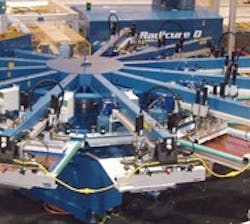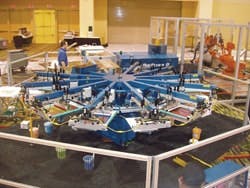How to Speed Up T-Shirt Printing
When a pro SPORTS team wins a conference or national title, many players instantly put on T-shirts and hats proclaiming victory. Almost as fast, there are thousands of the same shirts and hats on sale everywhere. So, how is this trick done? It takes seriously fast textile printing.
One machine builder that helps T-shirt makers and fans celebrate their long-awaited victories is M&R Printing Equipment (www.mrprint.com) in Glen Ellyn, Ill. Bo Biel, M&R’s chief electrical engineer, says his company has built carousel textile presses for 18 years, including its eight-year-old Sportsman press for continuous T-shirt printing and its RadiCure dryer, which uses radiant panels to melt plastic-based inks onto the shirts after they’re printed.
However, as Sportsman evolved to meet shirtmakers’ changing needs, M&R added devices and capabilities until its 12-station presses bristled with dozens of components from many suppliers. As a result, M&R worked with the low-voltage drives department in ABB’s (www.abb.us) automation products division over the past nine months to see if they could jointly build a Sportsman press using only ABB automation components. ABB’s organizers coordinated input and components from five business units and two divisions to help build M&R’s new carousel press.
“ABB previously supplied the Sportsman’s switch motor controls, AC drives and circuit breakers, but then they approached us with the idea of building it with all ABB components,” says Biel. “We usually pick the best components via trial-and-error, but this time we tried a one-for-one switch out of the PLC, HMI, servodrive, Modbus RTU networking and other solutions.”
T-Shirt-Go-Round
A modified Sportsman continuous carousel textile press from M&R Printing Equipment prints multi-colored images onto T-shirts, while a RadiCure dryer melts the plastic-based inks onto the fabric and a robot plucks the shirts from the line at ABB Automation & Power World 2009 in Orlando, Fla.
Click on Image to enlarge.
M&R and ABB’s engineers inventoried Sportsman’s existing devices and found they could switch more than 100 components, including drives, motors, PLCs, push buttons, pilot device switches, stack lights, contactors, relays, soft starters, e-stops and other parts. M&R’s staff then assembled them as part of the new machine.
“We also had 10 ac drives we needed to connect, but since RJ45 wasn’t approved for RS-485 communications, we added a Phoenix Contact communication module for the drives,” says Biel. “However, it was unpluggable and had to be terminated with a screwdriver. We needed that click, so eventually we converted these terminal blocks on the drive to an RJ45 socket, which gave us an Ethernet-like hub for the drives and other components. This finally lets us click in all 10 drives and other devices, and they’ve been working well.”
Now, the master PLC can talk to and monitor all the drives, says Biel. “This isn’t about deterministic control; it’s just about communicating to all devices and data exchange,” he says. “However, with one touch, we now can send a recipe on the HMI to all the drives. This makes setup much easier—in seconds instead of minutes.”


